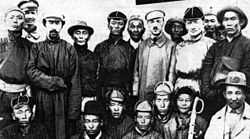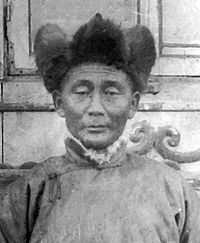Elbegdorj Rinchino

Rinchingiin Elbegdorj (Russian: Элбе́к-Доржи́ Ринчи́нович Ринчино́; May 16, 1888 –June 10, 1938), also called "Ėlbek-Dorzhi Rinchino", was a Buryat revolutionary who played leading roles in the Outer Mongolian Revolution of 1921 and the early political development of the Mongolian People's Republic.[1]
Early life and career
Elbegdorj was born on May 16, 1888 into a herding family in Barguzinsky District, Transbaikal. He became a communist around 1910 while studying at Saint Petersburg State University.[2] He then moved to Troitskosavsk where he wrote for a local newspaper and traveled throughout Mongolia, becoming involved in clandestine Mongolian revolutionary activities. Elbegdorj befriended a young Khorloogiin Choibalsan in Irkutsk between 1914 and 1918 and became a strong early influence on future Mongolian leader. [3]
Revolution of 1921
By 1920, Elbegdorj's connection to Mongolian revolutionary groups and his expertise on Mongolian affairs made him an indispensable part of Soviet efforts to steer Mongolia's early revolutionary development. In 1920 he organized the first meetings between Mongolian revolutionaries and members of the Revolutionary Military Committee of the Fifth Red Army and acted as the group's Russian interpreter. He also accompanied delegates Soliin Danzan and Dambyn Chagdarjav to Moscow where they met Russian communist leader Nikolay Bukharin. He was also a guiding presence at the first secret meeting of the Mongolian People's Party held in Troitskosavsk from March 1–3, 1921 (later known as the First Party Congress of the MPRP) where the provisional revolutionary government of Mongolia was established.
Following the Outer Mongolian Revolution of 1921 Elbegdorj was appointed head of the Mongolian army training and education department. Along with Choibalsan, he established the radicalized Mongolian Revolutionary Youth League (MRYL), through which he exerted a strong influence on the political orientation of Mongolian revolutionary policy in its early years. By this time he was recognized as one of the leading figures of Mongolia's revolutionary government[4] and with the backing he enjoyed from Moscow, he came to dominate the political scene in Ulan Bator, often emerging as victor from party infighting.[5] In 1922 he successfully collaborated with Soliin Danzan and Damdin Sükhbaatar to eliminate Prime Minister Dogsomyn Bodoo in a power struggle.[6]
Third Party Congress of 1924

After the purge of Bodoo, a rivalry developed between Elbegdorj and Danzan that came to a head at the Third Party Congress in 1924. Danzan had angered Elbegdorj and the Comintern when he sought to reduce the number of Soviet advisers in Mongolia, attempted to bring the radicalized Mongolian Revolutionary Youth League (MRYL) under party control, and resisted Soviet advice that Mongolia bypass capitalism and move directly to socialism. Recognized as leader of the party's leftist faction, Elbegdorj joined with rightists under Tseren-Ochiryn Dambadorj to orchestrate Danzan's the arrest and execution. At the Third Party Congress Danzan was Officially accused of representing bourgeois interests and engaging in business with Chinese firms.[7] Within a day Danzan and several colleagues were arrested and executed, sending a shock wave through the party that solidified Soviet dominance of Mongolian politics.
In the wake of the Third Party Congress, Rightists under Dambadorj assumed control and, during a period later referred to as the “Right Opportunism” (1925-1928), promoted rightist policies mirroring Lenin’s New Economic Policy in the Soviet Union. [8] Elbegdorj helped draft the country's 1924 Constitution (based largely on the Soviet constitution), [9] but soon thereafter saw his influence wane with the appointment of Turar Ryskulov as the new chief Comintern adviser in Ulaanbaatar in 1924.
Death
By 1925 Elbegdorj was accused of being a bourgeois nationalist[10] whose pan-Mongolian sentiments, expressed at the Third Party Congress in 1924, were seen as contrary to communist policy. The power struggle between Ryskulov and Elbegdorj eventually resulted in both being recalled to Moscow in 1928. He then taught at the Communist University of the Toilers of the East training many of the young MPRP members who attended the school. Elbegdorj was arrested in 1937 during the Great Purge, sentenced to death by the Military Collegium of the Soviet Supreme Court on June 4, 1938 and executed on June 10, 1938.
He was rehabilitated in 1957.
References
- ↑ Alan J. K. Sanders Historical dictionary of Mongolia. Rowman & Littlefield, 2003, ISBN 978-0-8108-4434-6
- ↑ Baabar (1999). History of Mongolia. Cambridge: Monsudar Publishing. p. 260. ISBN 9992900385.
- ↑ Baabar 1999, p. 260
- ↑ Bawden, C.R. (1989). The Modern History of Mongolia. London: Kegan Paul International Ltd. p. 239. ISBN 0-7103-0326-2.
- ↑ Baabar 1999, p. 205
- ↑ Baabar 1999, p. 261
- ↑ Sanders 2003, p. 52.
- ↑ Lattimore, Owen (1962). Nomads and Commissars: Mongolia Revisited. Oxford University Press. p. 119. ISBN 1258086107.
- ↑ Baabar 1999, p 270
- ↑ Rupen, Robert (1979). How Mongolia Is Really Ruled. Standford, CA: Hoover Institution Press. p. 161. ISBN 081797122X.